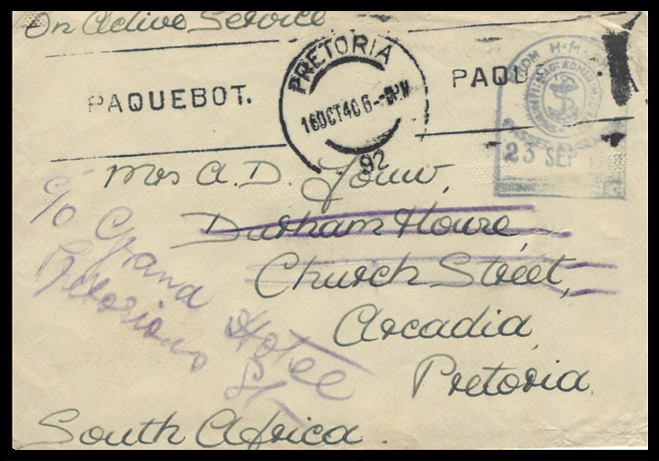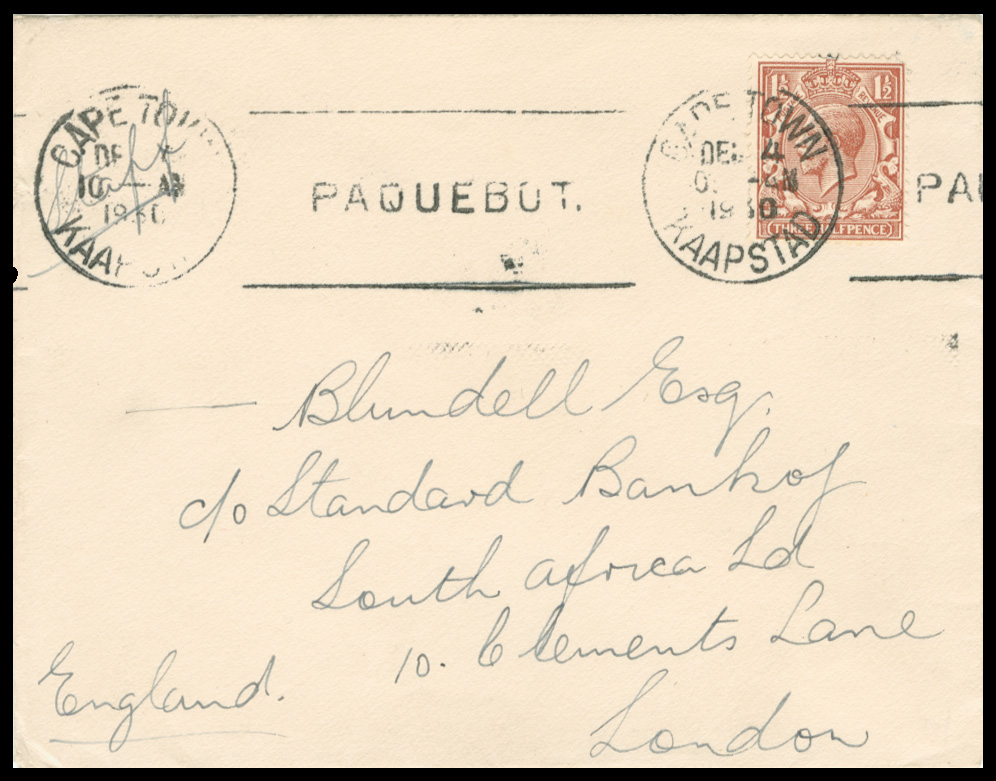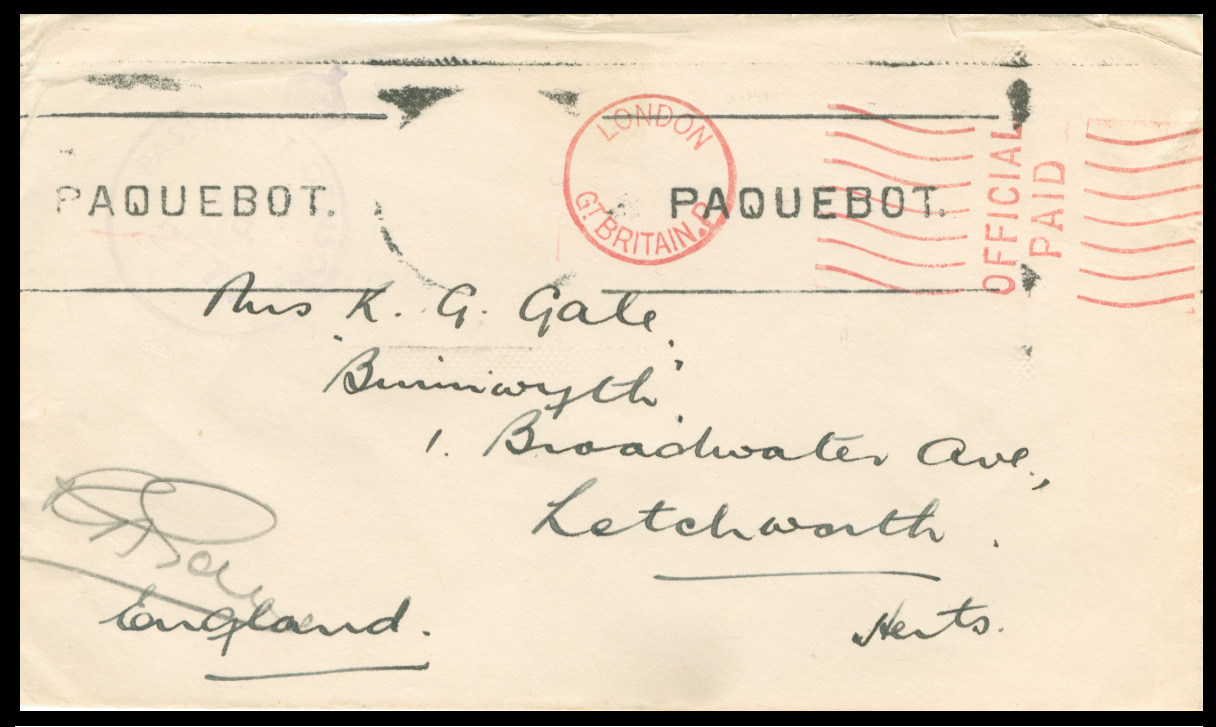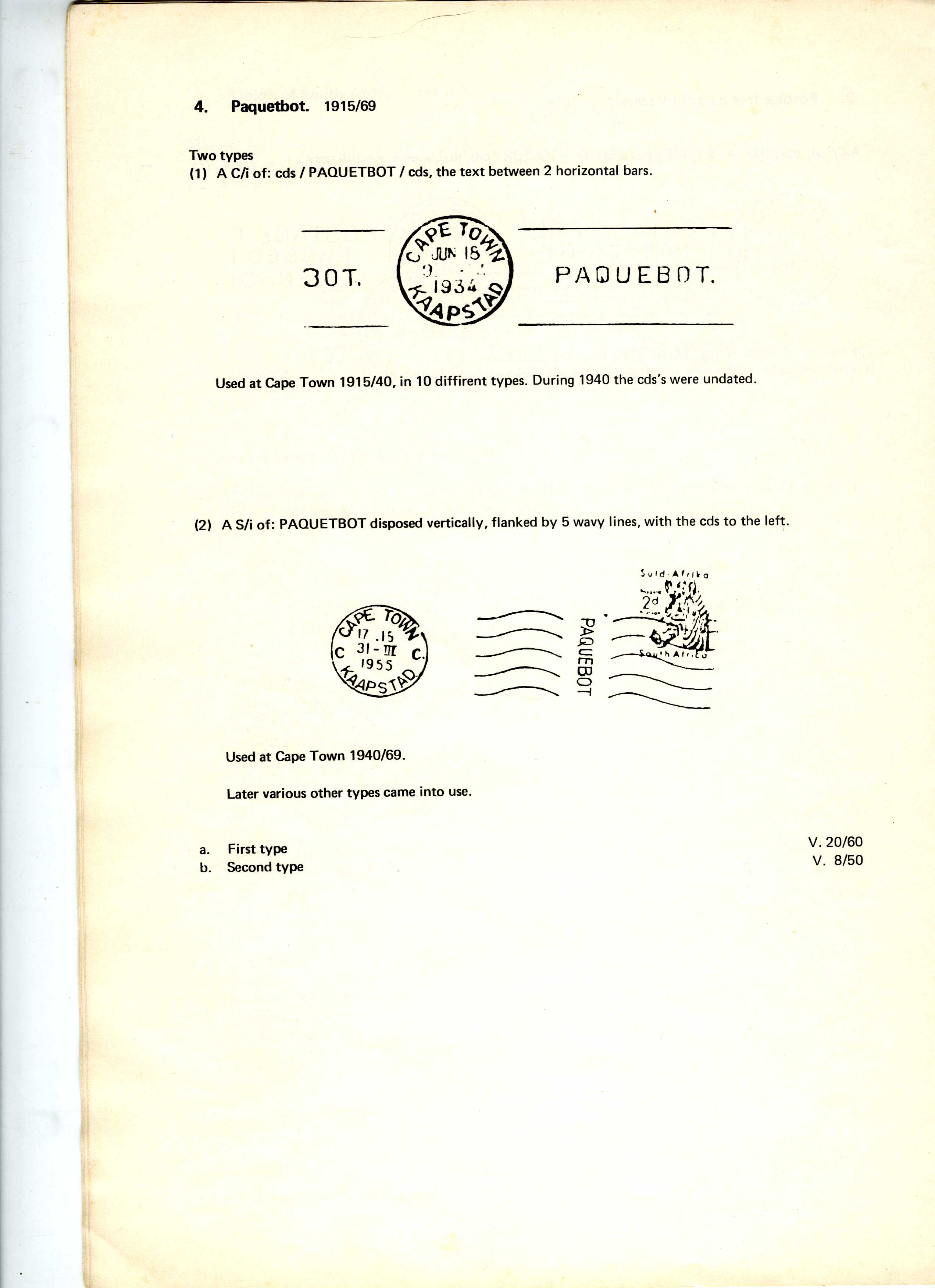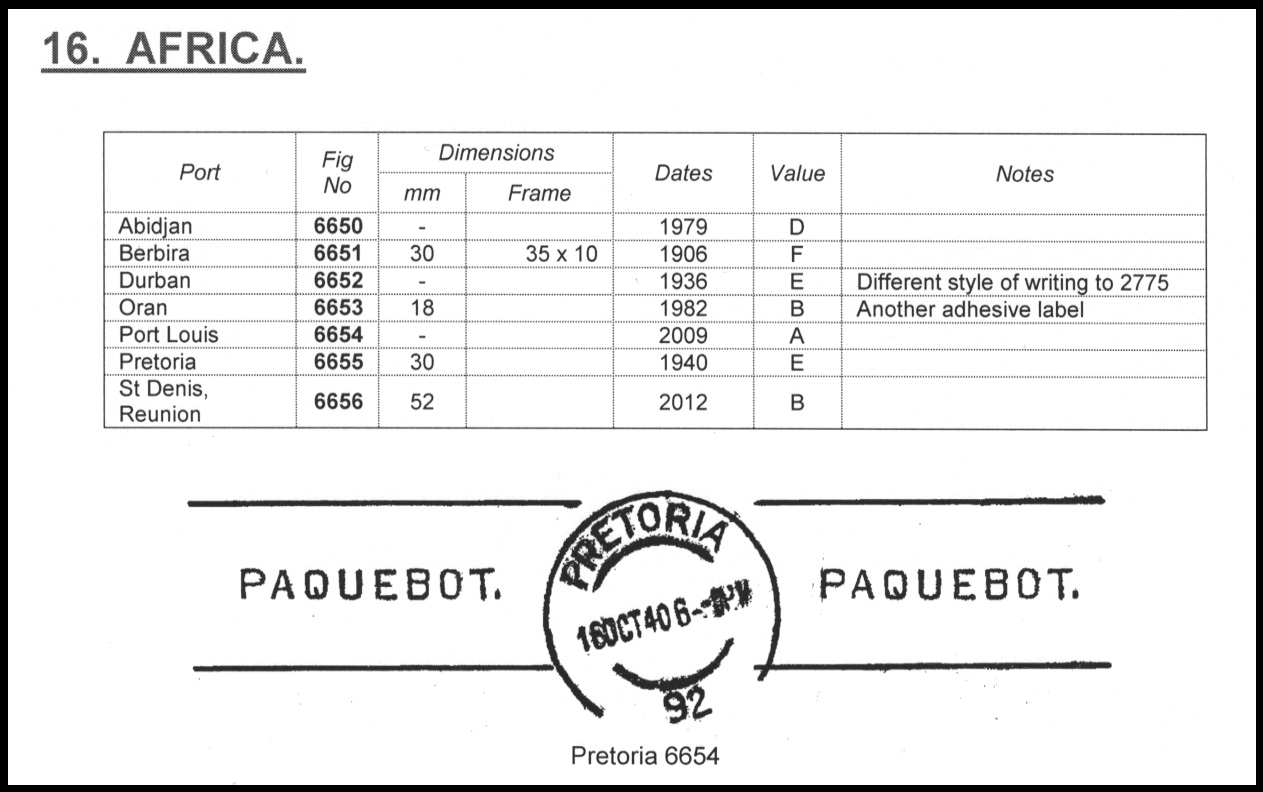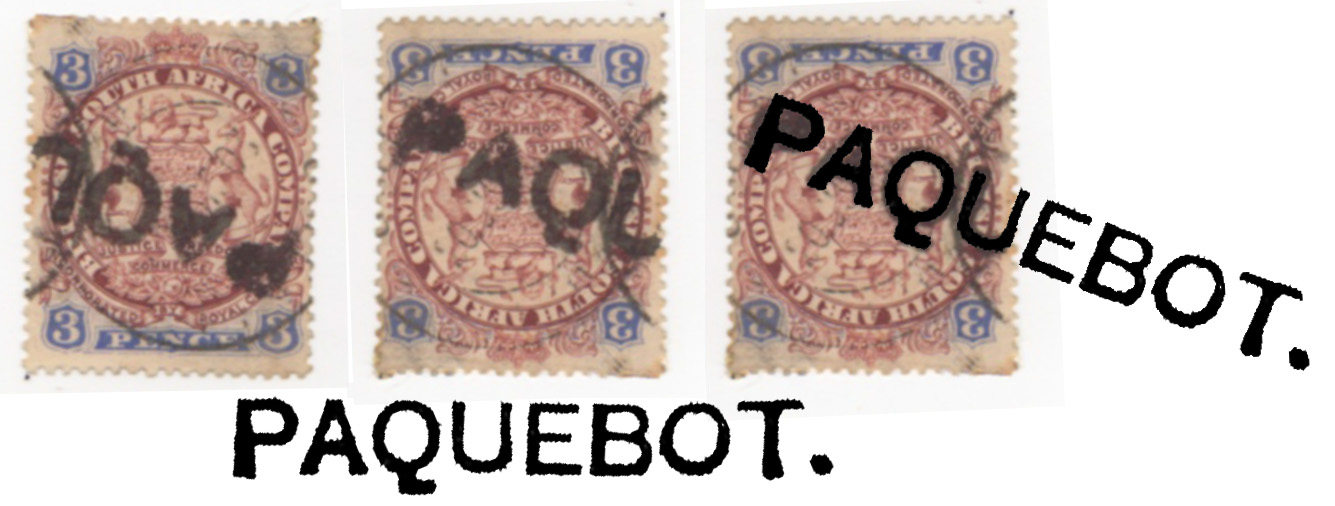The Pretoria Paquebot Mark!
Quote from Steve on March 27, 2021, 4:46 pmI recently bought the ‘Paquebot Cancellations of the the World and more...’ DVD which came with a leaflet promoting 'The 2020 ADDENDA' whose front cover displayed "the newly discovered Pretoria Paquebot Cover" of WW2 vintage.
I immediately thought "no way!". Most South African collectors will share my reservations about this. Pretoria is 300 miles from the sea and cannot be reached by sailing up the mighty Apies River. Clearly, the "Pretoria Paquebot Cover" is NOT what it seems to be. I do not think this is a deliberate fraud or hoax despite 1st April being only a few days away! It is the result of wishful thinking by Paquebot enthusiasts suspending disbelief. As far as I know, there are NO other examples of such a Pretoria Paquebot mark. Do you have one? No, I didn't think so. So what is it and why?
What are Paquebot Marks?
In 1892 the Swiss-based Universal Postal Union decreed that all ships were their own sovereign territory while on the high seas and outside of territorial waters. This allowed ships to act as postal authorities. Starting in 1894, Paquebot mail was soon an international convention that allowed ships’ passengers and crew to write letters, add stamps from the country in which the ship was registered and to post them in the ship's mailbox on board ship at sea for onward dispatch at the next port of call. As Pretoria was not a port, it was never part of the UPU Paquebot system!
While passengers and sailors are required to use the stamps of the country whose flag the vessel flies, it was also permissible for their letters to bear the receiving country's stamps provided these were posted in the ship's mailbox, sometimes also called the ‘closed mail bag’. The criteria for a letter receiving a Paquebot mark is the letter’s inclusion in the mail bag when these were taken to the nearest post office by a crew member, often the ship's purser, for entry into the UPU's international postal system. Sometimes hundreds, even thousands, of letters would come of a passenger ship in its mail bag. Machine cancellers like the practical Krag series made short work of franking them.
Today, Paquebot mail is is a popular and enthusiastically collected area of postal history. The fact that Paquebot specialists, specifically the publishers, the TPO (Travelling Post Offices) & Seapost Society, and its authors, Mike Dovey and Keith Morris, have allowed this "New Discovery" of the Pretoria Paquebot mark to go as far as to get onto the front cover of their 2020 Addendum to ‘Paquebot Cancellations of the the World and more...’ is surprising. To be fair, I believe they have some reservations about it also and have put it to their members to discuss.
How the so-called 'Pretorial Paquebot mark' came into existence.
As a wartime naval and maritime security precaution, some Paquebot machine cancellers had their datestamps removed. This cover came off a British warship in October 1940, probably in Cape Town, where it received such a dumb Paquebot machine canceller, PCOW's No. 2739. It was then sent to Pretoria where it was received with a Divided Double Circle Pretoria datestamp on '16 OCT 40'. (Editor. This statement by the author is now known to be incorrect. See Alex Visser's comments below. It was stamped 'PRETORIA' only after being re-routed.) As the cover was quite 'busy' the postal clerk consciously applied the datestamp to the only place at the top of the letter where there was empty space - between the parallel horizontal lines where the circular datestamp had been removed.
The application of the datestamp is slightly skew and rotated in relation to the horizontal lines and does not sit evenly. It is also far to large for a machine canceller's circular datestamp. Part of the outer circle overlaps the lower line at bottom right. You would expect it to be properly aligned if it was a 'proper' machine canceller. It is not!
I think this is an honest mistake on the part of the publishers of the PCOW ADDENDUM, in large part bought about by a failure of their own reference work to show more than one image of the different machine canceller types, as well as not properly listing the different varieties of machine canceller dies in a way that is easily understood and usable. Had they included an image of the dumb CAPE TOWN KAAPSTAD Paquebot mark in their book/DVD with, as they say in the small print, the "circular portion .... during WW2 removed", they might have been able to use their own reference work to better understand the origin of the so-called 'Pretoria Paquebot Mark'.
All this 'Pretoria Paquebot Mark' cover is is their No 2739 CAPE TOWN KAAPSTAD (possibly other) Paquebot mark with the circular portion removed and a Pretoria datestamp fortuitously and deliberately but, I believe, not mischeviously struck in the clear part of the datestampless machine cancellation. These experts can be forgiven for not identifying the postmark. This 35mm Divided Double Circle Pretoria 92 datestamp is not included in Putzel. It is a more recent discovery listed by Alex Visser in his on-line Addendum as No. 150r. I am not expert in machine cancellers but I would be willing to bet that few come with such a large high-numbered datestamp.
So, yes and somewhat sadly, the "Pretoria Paquebot Cover" is a coincidental hybrid, the result of two South African postmarks coming together to give the appearance of a new and unidentified one. A pity but to me as a postmark collector, it was obviously wrong from the moment I first saw it. Still, others are holding out in the hope that this is what they wish it to be. It is not!
Note that all the machine cancellers shown on the cover's below are despite their obvious differences all numbered No. 2739 according to PCOW. This is because PCOW lists only one machine canceller and assigns all its different circular dies with the same number. No attempt is made to list the different dies or to describe them meaningfully as Nos. 2739a, b or c. The absence of a visual reference and list of varieties is a shortcoming, one which has arguably facilitated the misidentification of the so-called 'Pretoria Paquebot Mark'.
I will shortly begin work on a first draft of Southern African Paquebot marks including datestamps and machine cancellers. I will post this as a Club Collective Display and invite you to send me your examples by email.
BELOW
Front Cover of PCOW 2020 Addenda.
The so-called 'Pretoria Paquebot Mark'.
No. 2739 of 1920 (earliest but not shown as such).
No. 2739 of 1930 (later but shown as the genus).
No. 2739 circa 1940 "with circular portion removed".
I recently bought the ‘Paquebot Cancellations of the the World and more...’ DVD which came with a leaflet promoting 'The 2020 ADDENDA' whose front cover displayed "the newly discovered Pretoria Paquebot Cover" of WW2 vintage.
I immediately thought "no way!". Most South African collectors will share my reservations about this. Pretoria is 300 miles from the sea and cannot be reached by sailing up the mighty Apies River. Clearly, the "Pretoria Paquebot Cover" is NOT what it seems to be. I do not think this is a deliberate fraud or hoax despite 1st April being only a few days away! It is the result of wishful thinking by Paquebot enthusiasts suspending disbelief. As far as I know, there are NO other examples of such a Pretoria Paquebot mark. Do you have one? No, I didn't think so. So what is it and why?
What are Paquebot Marks?
In 1892 the Swiss-based Universal Postal Union decreed that all ships were their own sovereign territory while on the high seas and outside of territorial waters. This allowed ships to act as postal authorities. Starting in 1894, Paquebot mail was soon an international convention that allowed ships’ passengers and crew to write letters, add stamps from the country in which the ship was registered and to post them in the ship's mailbox on board ship at sea for onward dispatch at the next port of call. As Pretoria was not a port, it was never part of the UPU Paquebot system!
While passengers and sailors are required to use the stamps of the country whose flag the vessel flies, it was also permissible for their letters to bear the receiving country's stamps provided these were posted in the ship's mailbox, sometimes also called the ‘closed mail bag’. The criteria for a letter receiving a Paquebot mark is the letter’s inclusion in the mail bag when these were taken to the nearest post office by a crew member, often the ship's purser, for entry into the UPU's international postal system. Sometimes hundreds, even thousands, of letters would come of a passenger ship in its mail bag. Machine cancellers like the practical Krag series made short work of franking them.
Today, Paquebot mail is is a popular and enthusiastically collected area of postal history. The fact that Paquebot specialists, specifically the publishers, the TPO (Travelling Post Offices) & Seapost Society, and its authors, Mike Dovey and Keith Morris, have allowed this "New Discovery" of the Pretoria Paquebot mark to go as far as to get onto the front cover of their 2020 Addendum to ‘Paquebot Cancellations of the the World and more...’ is surprising. To be fair, I believe they have some reservations about it also and have put it to their members to discuss.
How the so-called 'Pretorial Paquebot mark' came into existence.
As a wartime naval and maritime security precaution, some Paquebot machine cancellers had their datestamps removed. This cover came off a British warship in October 1940, probably in Cape Town, where it received such a dumb Paquebot machine canceller, PCOW's No. 2739. It was then sent to Pretoria where it was received with a Divided Double Circle Pretoria datestamp on '16 OCT 40'. (Editor. This statement by the author is now known to be incorrect. See Alex Visser's comments below. It was stamped 'PRETORIA' only after being re-routed.) As the cover was quite 'busy' the postal clerk consciously applied the datestamp to the only place at the top of the letter where there was empty space - between the parallel horizontal lines where the circular datestamp had been removed.
The application of the datestamp is slightly skew and rotated in relation to the horizontal lines and does not sit evenly. It is also far to large for a machine canceller's circular datestamp. Part of the outer circle overlaps the lower line at bottom right. You would expect it to be properly aligned if it was a 'proper' machine canceller. It is not!
I think this is an honest mistake on the part of the publishers of the PCOW ADDENDUM, in large part bought about by a failure of their own reference work to show more than one image of the different machine canceller types, as well as not properly listing the different varieties of machine canceller dies in a way that is easily understood and usable. Had they included an image of the dumb CAPE TOWN KAAPSTAD Paquebot mark in their book/DVD with, as they say in the small print, the "circular portion .... during WW2 removed", they might have been able to use their own reference work to better understand the origin of the so-called 'Pretoria Paquebot Mark'.
All this 'Pretoria Paquebot Mark' cover is is their No 2739 CAPE TOWN KAAPSTAD (possibly other) Paquebot mark with the circular portion removed and a Pretoria datestamp fortuitously and deliberately but, I believe, not mischeviously struck in the clear part of the datestampless machine cancellation. These experts can be forgiven for not identifying the postmark. This 35mm Divided Double Circle Pretoria 92 datestamp is not included in Putzel. It is a more recent discovery listed by Alex Visser in his on-line Addendum as No. 150r. I am not expert in machine cancellers but I would be willing to bet that few come with such a large high-numbered datestamp.
So, yes and somewhat sadly, the "Pretoria Paquebot Cover" is a coincidental hybrid, the result of two South African postmarks coming together to give the appearance of a new and unidentified one. A pity but to me as a postmark collector, it was obviously wrong from the moment I first saw it. Still, others are holding out in the hope that this is what they wish it to be. It is not!
Note that all the machine cancellers shown on the cover's below are despite their obvious differences all numbered No. 2739 according to PCOW. This is because PCOW lists only one machine canceller and assigns all its different circular dies with the same number. No attempt is made to list the different dies or to describe them meaningfully as Nos. 2739a, b or c. The absence of a visual reference and list of varieties is a shortcoming, one which has arguably facilitated the misidentification of the so-called 'Pretoria Paquebot Mark'.
I will shortly begin work on a first draft of Southern African Paquebot marks including datestamps and machine cancellers. I will post this as a Club Collective Display and invite you to send me your examples by email.
BELOW
Front Cover of PCOW 2020 Addenda.
The so-called 'Pretoria Paquebot Mark'.
No. 2739 of 1920 (earliest but not shown as such).
No. 2739 of 1930 (later but shown as the genus).
No. 2739 circa 1940 "with circular portion removed".
Quote from Jamie Smith on March 27, 2021, 7:03 pmThe nearest I ever saw the South African Navy to Pretoria was on the lake in the middle of Centurian, when they had a Patrol boat with two sailors patrolling there. that would be about 1995.
And remember they also had a base at Wemmer Lake in Johannesburg! 1970s?
Wonder what they did about their mail?
PS - I would love that cover!!!!!!!!!!!!!!!!!!!!!!!!
The nearest I ever saw the South African Navy to Pretoria was on the lake in the middle of Centurian, when they had a Patrol boat with two sailors patrolling there. that would be about 1995.
And remember they also had a base at Wemmer Lake in Johannesburg! 1970s?
Wonder what they did about their mail?
PS - I would love that cover!!!!!!!!!!!!!!!!!!!!!!!!
Quote from Bas PAYNE on March 27, 2021, 7:05 pmYour suggestion that this letter was first cancelled in Cape Town with a "dumb" Paquebot machine cancellation (used during WW2 without the Cape Town circular date stamp for security reasons), and that, on arrival in Pretoria, a PO clerk with a sense of humour added a Pretoria hand-cancellation in the gap, is undoubtedly right - if the circular date stamp belonged with the machine cancellation, it would have been properly aligned, smaller (the date stamps in these Krag cancellers were 25 mm in diameter), and there would be part of another date stamp on the left side of the cover.
To provide context, I attach the relevant page from Steve Vermaak's "South African postal slogans" (1979), and a more detailed draft listing of the date stamps that I have seen with this slogan. If anyone can add to this, I would be delighted to hear from them.
Your suggestion that this letter was first cancelled in Cape Town with a "dumb" Paquebot machine cancellation (used during WW2 without the Cape Town circular date stamp for security reasons), and that, on arrival in Pretoria, a PO clerk with a sense of humour added a Pretoria hand-cancellation in the gap, is undoubtedly right - if the circular date stamp belonged with the machine cancellation, it would have been properly aligned, smaller (the date stamps in these Krag cancellers were 25 mm in diameter), and there would be part of another date stamp on the left side of the cover.
To provide context, I attach the relevant page from Steve Vermaak's "South African postal slogans" (1979), and a more detailed draft listing of the date stamps that I have seen with this slogan. If anyone can add to this, I would be delighted to hear from them.
Uploaded files:
Quote from Steve on March 28, 2021, 9:25 amMany thanks for the unequivocal support and the supplied images. Your Cape Town-Paquebot-draft PDF is particularly helpful in understanding the progression of the different types of PCOW No. 2736 machine canceller dies into the dumb Paquebot of WW2. It would be good to hear from someone making the case for the Pretoria Paquebot mark.
Below is the listing from Paquebot Cancellations of The World Addenda 2020 which list Pretoria with No. 6655, err..no it's 6654! Confusion surrounds the so-called Pretoria Paquebot mark which should NOT be listed at all! It is NOT a bona fide Paquebot Mark. It is, at best, merely a conversation piece.
Many thanks for the unequivocal support and the supplied images. Your Cape Town-Paquebot-draft PDF is particularly helpful in understanding the progression of the different types of PCOW No. 2736 machine canceller dies into the dumb Paquebot of WW2. It would be good to hear from someone making the case for the Pretoria Paquebot mark.
Below is the listing from Paquebot Cancellations of The World Addenda 2020 which list Pretoria with No. 6655, err..no it's 6654! Confusion surrounds the so-called Pretoria Paquebot mark which should NOT be listed at all! It is NOT a bona fide Paquebot Mark. It is, at best, merely a conversation piece.
Uploaded files:Quote from Steve on March 29, 2021, 10:06 amMike Berry writes: "We must raise a section "PAQUEBOT FURTHEST FROM THE SEA". (Only joking). Here is one struggling a little from Rhodesia. I doubt it went down the Zambezi - too many mountains and waterfalls between. Most likely down by rail to Beira to catch a vessel!"
Just to clarify, Mike, it would have gone up the Zambezi to reach its destination in Rhodesia, not down. (My turn to joke!) Paquebot marks were applied to mail coming off a ship, not going onto it (as far as I know).
Portuguese East Africa was my first thought also. I had a quick look in "Paquebot Cancellations of the World". It does not appear to be Beira or LM. However, I saw this for DURBAN. It is No. 2772 with dimensions of 45.5mm with a date of 1899 - 1900 which is about right for this British South Africa Co. stamp. What identifies this as the Durban Paquebot mark is the 'Q' whose tail does not start inside the letter but which is attached only to its outside.
Also, the UPU requirement was that the stamps used should be that of the country of this ship's origin or the country applying the Paquebot mark. The ship was most likely a British mailship travelling to SA from Southampton. Technically, a BSA Co. stamp should not have been valid. It needed a British or a Natal stamp. Unless, of course, the mailship had originated in the territory that was soon to be known as Rhodesia. (Only joking... again!).
Mike Berry writes: "We must raise a section "PAQUEBOT FURTHEST FROM THE SEA". (Only joking). Here is one struggling a little from Rhodesia. I doubt it went down the Zambezi - too many mountains and waterfalls between. Most likely down by rail to Beira to catch a vessel!"
Just to clarify, Mike, it would have gone up the Zambezi to reach its destination in Rhodesia, not down. (My turn to joke!) Paquebot marks were applied to mail coming off a ship, not going onto it (as far as I know).
Portuguese East Africa was my first thought also. I had a quick look in "Paquebot Cancellations of the World". It does not appear to be Beira or LM. However, I saw this for DURBAN. It is No. 2772 with dimensions of 45.5mm with a date of 1899 - 1900 which is about right for this British South Africa Co. stamp. What identifies this as the Durban Paquebot mark is the 'Q' whose tail does not start inside the letter but which is attached only to its outside.
Also, the UPU requirement was that the stamps used should be that of the country of this ship's origin or the country applying the Paquebot mark. The ship was most likely a British mailship travelling to SA from Southampton. Technically, a BSA Co. stamp should not have been valid. It needed a British or a Natal stamp. Unless, of course, the mailship had originated in the territory that was soon to be known as Rhodesia. (Only joking... again!).
Uploaded files:Quote from Steve on March 30, 2021, 4:24 pmI have received the following advice from Prof. Alex Visser. It is fitting that he has the last word on this subject. Alex has assumed the heavy mantle of continuing Ralph Putzel's work identifying South African postmarks. Alex now has an on-line addendum to Ralph's work that is about the same size as the original. Alex is also well-known for his column "Phun with Postmarks" in the SA Philatelist.
Unsurprisingly, Alex has identified and solved the last part of the Pretoria Paquebout mark puzzle, namely how, where and why the Double Circle Pretoria Counter 92 datestamp was added to the cover.
Alex Visser writes: "You had me intrigued about the Pretoria Paquebot. I think the explanation is quite elementary. As you point out, the letter originated from a warship, dated 23 SEP 1940 as indicated by the tombstone cancellation. Then probably into the mail system in Cape Town, where the machine canceller without date was applied, to Pretoria. There was no need for a transit mark when it arrived in Pretoria where it was delivered. The letter was re-directed as Mrs Louw had moved to the Grand Hotel. The double circle Pretoria counter 92 date stamp was used in the sorting office (most of the date stamps with counter number in the 90s were used in the sorting office) and it was correctly dated. Since the cover did not have many open spaces to apply this date stamp, the space in the machine canceller was used. And hopefully Mrs Louw received her letter."
Many thanks, Alex. The so-called Pretoria Paquebot mark can now be seen as simply the coming togther of two perfectly ordinary South African postmarks to create something that has the appearance of being extraordinary.
I have received the following advice from Prof. Alex Visser. It is fitting that he has the last word on this subject. Alex has assumed the heavy mantle of continuing Ralph Putzel's work identifying South African postmarks. Alex now has an on-line addendum to Ralph's work that is about the same size as the original. Alex is also well-known for his column "Phun with Postmarks" in the SA Philatelist.
Unsurprisingly, Alex has identified and solved the last part of the Pretoria Paquebout mark puzzle, namely how, where and why the Double Circle Pretoria Counter 92 datestamp was added to the cover.
Alex Visser writes: "You had me intrigued about the Pretoria Paquebot. I think the explanation is quite elementary. As you point out, the letter originated from a warship, dated 23 SEP 1940 as indicated by the tombstone cancellation. Then probably into the mail system in Cape Town, where the machine canceller without date was applied, to Pretoria. There was no need for a transit mark when it arrived in Pretoria where it was delivered. The letter was re-directed as Mrs Louw had moved to the Grand Hotel. The double circle Pretoria counter 92 date stamp was used in the sorting office (most of the date stamps with counter number in the 90s were used in the sorting office) and it was correctly dated. Since the cover did not have many open spaces to apply this date stamp, the space in the machine canceller was used. And hopefully Mrs Louw received her letter."
Many thanks, Alex. The so-called Pretoria Paquebot mark can now be seen as simply the coming togther of two perfectly ordinary South African postmarks to create something that has the appearance of being extraordinary.
Quote from Underbidder on April 3, 2021, 5:00 pmI have had a very close look at this Paquebot mark. In addition to your other observations, the ink appears lighter and different in the MC to the heavier and darker ink in the double circle 92 date stamp. On that basis, I believe these are two different postmarks. Also, Alex's advice about the Hotel re-directing the letter and it going back to the Pretoria Post Office to be cancelled in its sorting office ends any possibility that this is a genuine Pretoria Paquebot mark.
I have had a very close look at this Paquebot mark. In addition to your other observations, the ink appears lighter and different in the MC to the heavier and darker ink in the double circle 92 date stamp. On that basis, I believe these are two different postmarks. Also, Alex's advice about the Hotel re-directing the letter and it going back to the Pretoria Post Office to be cancelled in its sorting office ends any possibility that this is a genuine Pretoria Paquebot mark.


